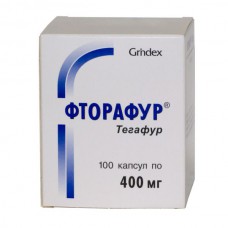Expiration date: 01/2026
Form of issue and composition:
Capsules solid gelatin, with a yellow body and an orange lid the contents of the capsules-white powder without odor.
1 capsule contains tegafur 400 mg
Excipients: stearic acid.
Capsule shell composition: gelatin, titanium dioxide (E171), Quinine yew (E104), Pnceau 4R (E124).
100 PCs. - polyethylene cans with a capacity of 150 ml (1) - cardboard boxes.
Pharmacological action:
Antitumor drug, the effect of which is due to a violation of the synthesis of DNA and RNA. The resulting hydrolysis fluorouracil inhibits the enzyme thymidylate synthetase and DNA synthesis, introduced into the RNA structure instead of uracil, making it defective, and inhibits cell proliferation.
In tumor cells transformed into 5-fluoro-deoxyuridine-5-monophosphate, which then fosfauriliruetsa to triphosphate and is included in the RNA, and floxuridine monophosphate, which inhibits timidilatsintetazu. Less toxic and better tolerated by patients than 5-fluorouracil.
Pharmacokinetics:
When ingested, tegafur is rapidly absorbed from the gastrointestinal tract and is found in the blood for at least 24 hours after a single application. Cmax tegafur in blood plasma is achieved within 4-6 hours after administration. Bioavailability is almost complete.
It has a high lipophilicity (200 times higher than fluorouracil), while remaining a water-soluble compound. High lipophilicity ensures rapid passage through biological membranes, distribution in the body and penetration through the BBB.
Metabolized in the liver to form metabolites, among which the Central place is pharmacologically active 5-fluorouracil. Bioactivation is carried out not only in the liver, but can also be local in tumor tissue, characterized by an increased content of cytosolic hydrolytic enzymes.
Compared with tegafur, the concentration of 5-fluorouracil is much lower, but more stable.
Indications:
- colon and rectal cancer
- stomach cancer
- breast cancer
- atopic eczema
- skin lymphomas.
Dosage regimen:
Assign inside. Ftorafura daily dose is 800-1000 mg/m2 (20-30 mg/kg of body weight) 2-4 doses, but not more than 2 g/day. The course dose when administered is 30-40 g. the Interval between courses is 4 weeks. Dose Ftorafura may be reduced in elderly patients and late stage of the disease.
Side effect:
From the hematopoietic system: leukopenia, thrombocytopenia, anemia.
From the digestive system: nausea, vomiting, anorexia, abdominal pain, diarrhea rarely - stomatitis, esophagitis, ulcerative lesions of the gastrointestinal mucosa, gastrointestinal bleeding, liver dysfunction, acute hepatitis, acute pancreatitis.
CNS: dizziness, confusion, drowsiness, ataxia, euphoria, symptoms of leukoencephalitis.
From the cardiovascular system: cardialgia, angina, myocardial ischemia, myocardial infarction.
From the senses: diplopia, lacrimation, fibrosis of the lacrimal ducts, loss of smell.
Dermatological reactions: alopecia, impaired regeneration of the skin, nails.
Other: pharyngitis, allergic reactions (including anaphylactic shock) renal dysfunction, dehydration, interstitial pneumonia.
Contraindications:
- terminal stage of the disease
- acute profuse bleeding
- severe hepatic impairment
- severe renal impairment
- leukopenia (less than 3000 / µl)
- thrombocytopenia (less than 100 000 / µl)
- anemia (hemoglobin level less than 65 g / l)
- pregnancy
- lactation (breastfeeding)
- hypersensitivity to the drug.
With caution, the drug should be used in patients with impaired hematopoiesis, liver and kidney function, glucose metabolism, gastric ulcer and duodenal ulcer, bleeding tendency, with infectious diseases.
Pregnancy and lactation:
Ftorafur is contraindicated in pregnancy and lactation (breastfeeding).
It should be borne in mind that the drug inhibits the reproductive function of the patient.
Special instruction:
If necessary, the appointment of Ftorafura patients with impaired hematopoiesis, liver and kidney function, glucose metabolism, gastric ulcer and duodenal ulcer, a tendency to hemorrhage, infectious diseases should take into account the potential risk of adverse reactions. During treatment should regularly monitor the picture of peripheral blood, the functional state of the liver and kidneys. With prolonged use of the drug, its side effect increases.
Dizziness, nausea and vomiting are reduced by fractionation of the daily dose.
With the development of serious side effects, it is necessary to stop the use of the drug.
Use in Pediatrics
The safety of the drug in children has not been established.
Overdose:
Symptoms: increased toxic effects of the gastrointestinal tract, Central nervous system and inhibition of hematopoiesis.
Treatment: control of hematopoietic function for at least 4 weeks, if necessary, symptomatic therapy. The specific antidote to the tegafur is unknown.
Drug interaction:
With the simultaneous use of Ftorafura and phenytoin may increase the effect of the latter.
Ftorafur increases the effectiveness of other chemotherapeutic agents and radiation therapy (enhanced and side effects).
While the use of inhibitors of microsomal oxidation in the liver increases the toxicity of Fluorophur.
Terms and conditions of storage:
A list of the Drug should be stored in a dark place, inaccessible to children at a temperature above 25°C.


